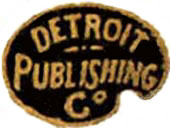| |

|
| |
| |
| |
How
to Color Photographs:
Detroit
Publishing Company photographs were initially shot in
black and white. The photographer would take notes
describing the scene and the colors. After he developed
the photograph, the production manager would mark up the
color instructions on a print and a retoucher would color
the print. Color prints were then produced by lithography,
a process of printing from a flat surface on which the
image to be printed is ink-receptive and the blank area
is ink-repellent. The Detroit Publishing Company
held the exclusive North American rights to Photochrom,
a Swiss-patented method of color lithography.
Jump
to a subsection:
Taking a Picture | Retouching
| One Photograph, many Pictures
| How to Color Photographs
|
|
|
|
| |
( 30
of 33 ) |
 |
|
|
The
method of transferring a hand-colored photograph to multiple
printing plates uses separation negatives, one for each
color. The colorized original is re-photographed through
different colored filters onto black and white negatives,
one for each color. The negatives are then transferred
onto the printing plates. Up to twenty color separations
might be produced for one Photochrom lithograph print.
Note the progression from black ink to nine colors in these
examples of the company’s postcard proof sheets from
about 1900.
Larger
version of image and others in progression (may be more
than 50k)
|

Accession
ID # 37.102.126 |
| |
|
|
|
|
|
|
Copyright
© 2003
The Henry Ford Last
Updated:
01/17/2003
|
|
|
|
